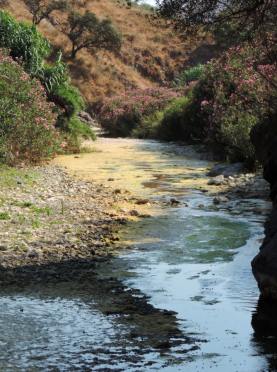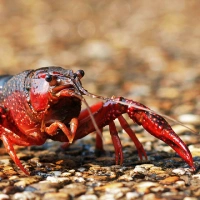Special issue of Hydrobiologia makes the case for unique Mediterranean-climate streams
Mediterranean-climate streams and rivers are ecologically unique, getting their distinctiveness from the double risk of both flood and drought. According to BioFresh partners Núria Bonada and Vincent Resh, they are also some of the most stressed rivers in the world. Bonada and Resh overview August’s special issue of Hydrobiologia, where the focus is all on such “med-rivers.” Their paper, a meta-assessment of over 20 review articles published in the issue, covers the unique qualities of these rivers and their threats, both natural and human-caused, as well as what management and research need to do about them.

Mediterranean rivers and streams are unique both in their climatic conditions and their biodiversity. Photo courtesy Núria Bonada
Med-climate regions are found far beyond the Mediterranean basin itself. Rivers with a similar climate run through central Chile, coastal California, the Cape region of South Africa, and southwestern and southern Australia. These regions are unique because they fall in the middle the continuum between temperate climates and deserts, so life has to exist under special conditions. The signature of the Mediterranean climate is its strongly defined seasons, with hot, dry summers and cooler, rainy winters. Both flooding and drought are regular events for species living in med-rivers; however, as Bonada and Resh point out, the intensity of those events is not so predictable.
The swing from flood to drought and back again means that in order to survive in such varying conditions, species need a unique set of adaptations. Inhabitants of med-rivers, says Resh, “must be able to cope with dry-season droughts that result in reductions and sometime even loss of habitat, coupled with wet-season flooding,” and the adaptations for each extreme are very different. These adaptations echo across widely separated regions – explorers in the mid-1700s to the Cape, Chile, and Australia all noticed plants that strongly resembled Mediterranean species. Even species communities change as the seasons wax and wane, so visiting a med-river in the dry season, you might find different species dominating than in winter. “Mediterranean-climate rivers, especially small streams, are among the most stressful aquatic environments for organisms to live in,” says Resh.
Being used to extreme, but predictable disturbances means that these systems are especially vulnerable to human disruption. People have been changing the Mediterranean landscape since Neolithic times, and today agriculture, industry and growing human populations create a whole host of pressures, from decreasing water flow and changing temperature and light conditions to causing pollution, habitat fragmentation and biological invasions. Climate change is also expected to challenge med-climate streams as drought conditions worsen and extreme floods and heat waves become more common. All Mediterranean regions are expected to experience more warming than the global average, while precipitation decreases. Human competition for scarcer water may profoundly change natural communities in these rivers.

Human competition for scarce water resources is expected to have an increasing influence on med-rivers and the species that inhabit them. Photo courtesy Núria Bonada
To tackle these challenges, Bonada and Resh point to several critical areas for future research. While some med-climate streams have established baseline knowledge and grounded policy such as the EU’s Water Framework Directive to improve their ecological status, rivers in Chile, North African and Middle Eastern countries are less studied. Even basic ecological information is often lacking. Med-regions are freshwater biodiversity hotspots, but “in most regions the knowledge of this biodiversity is scarce and fragmented,” says Bonada. “Therefore, many species will move from being unknown to being lost under the current threats they are facing.” The colleagues suggest that international research programs should be encouraged, to exchange scientists between these med-regions and to fund research in med-regions worldwide. They also emphasize the importance of platforms such as BioFresh, whose role in collecting data from museums and researchers increases our knowledge about biodiversity and distributions in vulnerable areas such as med-regions.














